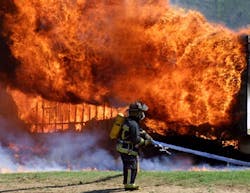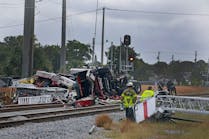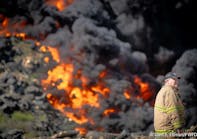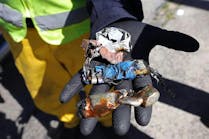While much has been discussed and presented about proper size up and advancing the initial attack hose line, we sometimes loose sight of the fact that to be effective, the line not only must be stretched in the right place, but must also flow enough water to kill, or at least stop the spread of the fire.
All too often, we see reports and photos of fires where the first line stretched was the “all purpose”, 200’ 1-3/4” handline with ineffective, and in some cases, disastrous results. Will the 1-3/4” hose line put out fire—of course. But, keep in mind that it might be (and has been) overwhelmed by a large body of fire, and 200’ may find you far short of your objective.
It’s a matter of physics that to reduce the combustion energy being produced by a given size fire, a proportionate amount of cooling or oxygen-inhibiting effort must be applied. If this effort is any less than what is needed to overcome the heat being produced, the fire will continue to burn.
The first step in selecting a properly sized hose line is to make sure that the officer is able to quickly select from a variety of options.
If two 1-3/4” cross lay hose beds are the only preconnected lines carried, then the tendency might be to stretch one of those lines on all fires, whether the line would flow enough water to be effective or not, simply because it would be the quickest and easiest line to deploy.
The simple addition of a 2-1/2” preconnected line now gives the officer a second option for use on large area/heavy fire load fires in commercial and industrial occupancies, as well as a high-volume knock-down line for well-involved dwelling fires.
Giving the officer options in hose line sizes and hose lengths go a long way in killing the fire more quickly and safely.
There are a number of things to consider when planning hose line options, however the three most important considerations are (1) how much water is the line going to flow, (2) how is the crew going to stretch and handle the line and (3) do you have enough hose to reach your objective.
Flow rate is the most important consideration when planning attack line operations. The type of nozzle is secondary to the amount of water the line and its crew can realistically apply to the fire. I worked with a number of departments that thought they could get 200 to 300-GPM from a 1-3/4” line. While this is theoretically possible, the combination of high engine pressures, an extremely stiff line and extremely high nozzle reaction forces makes high flow rates through small diameter hose something that proves dangerous and unpractical on the fire ground. And closing the shutoff to reduce the nozzle reaction forces doesn’t cut it when fighting a fire. Closing the shutoff will reduce the flow rate, and what you end up with is a low, but easily managed, flow rate being supplied through an extremely hard-to-bend hose
line.
NFPA #1710*, states that the initial arriving companies should be able to establish an initial fire flow of 300-GPM from two hand lines, each of which should have a minimum flow rate of 100-GPM. While this can be done with 1-3/4” hose, you will need some practice and extra folks to make it work at 150-GPM each.
Let’s consider some options.
So, what’s wrong with 1-1/2” line? Absolutely nothing. It can practically flow up to about 150-GPM with the proper nozzle, and is light weight and easily handled. For years, departments have been replacing 1-1/2” hose with 1-3/4” to gain the flow rate advantage offered by reduced friction losses in the larger diameter line. Unfortunately, in many cases, they fail to upgrade their nozzles at the same time, using the same devices they took off their 1-1/2” lines. The result is that the flow rate increased little if at all. Why pay more for hose unless you plan on changing out the business end hardware as well? If you are presently using 1-1/2” line, take a look at 125 to 150-GPM combination nozzles that operate at 50 to 75-PSI nozzle pressures. In many cases, older nozzles can be easily converted with new spacers or stems to flow more water at lower pressures. If you have budget problems, you don’t necessarily need to spend a lot of money to increase your firepower.
In real life, an 1-3/4” handline can comfortably and safely flow from 100 to 180-GPM on the fireground, and any flows over 150-GPM are best run through low pressure combination or smooth bore nozzles to reduce nozzle reaction forces. Also keep in mind that at flows over 150-GPM, you will need at least three firefighters to properly advance the line and handle the reaction forces.
If you plan to use a 2-1/2” attack line, keep in mind the size and weight of the hose makes it very staffing-intensive, especially when used offensively. With practice, two members can deploy an uncharged line, secure the business end and flow 250-GPM for defensive operations with relative ease. The problem comes when you want to move it—there is just no getting away from the fact that you need 3 or 4 members to pick up the line and get it where it needs to go. Also take a close look at your business end hardware. A fog nozzle operating with a 100-PSI nozzle operating pressure and a brass playpipe might not be the best choice for easy and safe handling.
Keep in mind that a through, 360-degree size up must happen before you can properly select the right sized hose line. Pulling a line should not be determined by, “that’s what we always use,” or “it’s easier to handle than a 2-1/2”. Your people should recognize when more water is needed and be trained enough to be comfortable handling whatever line is ordered into service.
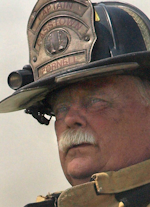
Capt. Dave Fornell
Captain David P. Fornell is active as a line officer in the Casstown Community Fire Department, Casstown, OH, protecting 88 square miles of rural area in and around Casstown, Ohio. He formerly held the rank of Captain of the Beckerle & Company, Hose Company, Engine #9 of the Danbury, Connecticut fire department protecting a busy city of 85,000, and was the full time Chief of the Westchester, Illinois fire department, a suburb of Chicago. He started his career as a firefighter in the Addison, IL Fire Department, located about 20 miles west of Chicago. Capt. Fornell is a certified fire service instructor specializing in engine company operations, company officer development and fire ground safety courses and he holds the rank of Honorary Battalion Chief of the FDNY. He is the author of "FIRE STREAM MANAGEMENT HANDBOOK" along with an accompanying training video published by Fire Engineering Books and Videos, and served seven years as the Executive Editor of FIRE APPARATUS magazine. Capt. Fornell has written articles for FIRE ENGINEERING and FIREHOUSE magazines in the U.S., FIRE AND RESCUE and MILITARY FIREFIGHTER in the United Kingdom. He has hosted the rural water supply, engine company operations and line officer training segments of "THE FIRST LINE SUPERVISOR" for the FETN television network.
